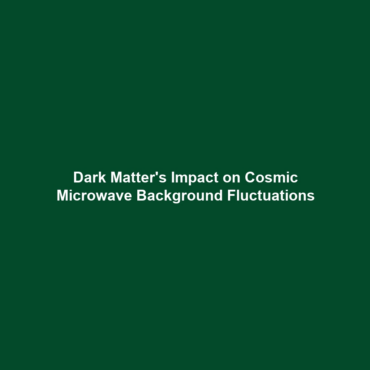The Influence of Dark Matter on Cosmic Microwave Background (CMB) Fluctuations
The influence of dark matter on cosmic microwave background (CMB) fluctuations is a critical area of research that can unravel many mysteries of the universe. Understanding this intricate relationship is paramount to comprehending the roles of dark matter and dark energy in cosmology. As scientists delve deeper into the cosmos, the fluctuations of the CMB—an afterglow of the Big Bang—reveal insight about the structure and evolution of the universe. This article examines the significance of this influence and its broader implications.
Key Concepts
Understanding Dark Matter and CMB
Dark matter is an invisible form of matter that does not emit light or energy, making it undetectable through conventional means. It is hypothesized to constitute about 27% of the universe’s total mass-energy content. CMB fluctuations are variations in temperature that can be detected in the CMB radiation and arise from density perturbations in the early universe.
The Influence on Structure Formation
Dark matter plays a critical role in the formation of structures in the universe. Its gravitational effects dictate how visible matter clumps together, contributing to the temperature fluctuations observed in the CMB. These fluctuations provide a cosmic blueprint that helps cosmologists understand how galaxies and clusters formed.
Applications and Real-World Uses
Understanding how dark matter influences CMB fluctuations has several applications, primarily in cosmology and astronomy. Some notable uses include:
- Cosmological Models: The analysis of CMB data helps refine models of the universe’s expansion and structure.
- Gravitational Lensing Studies: Dark matter’s influence on light paths informs studies of gravitational lensing, allowing scientists to map dark matter distribution.
- Quantum Cosmology: Insights from CMB fluctuations inform theories in quantum cosmology, exploring the universe’s earliest moments.
Current Challenges
Despite advancements in the study of dark matter and CMB fluctuations, researchers face several challenges:
- Detection Limitations: The elusive nature of dark matter makes it difficult to study directly.
- Theoretical Models: Existing models struggle to fully explain the complexities of CMB fluctuations.
- Instrumentation: Developing more sensitive instruments for better data collection is an ongoing challenge.
Future Research and Innovations
The future of research concerning the influence of dark matter on CMB fluctuations looks promising with several innovations on the horizon:
- Next-Generation Telescopes: Projects like the James Webb Space Telescope aim to provide deeper insights into CMB fluctuations.
- Machine Learning Algorithms: AI is increasingly used to analyze vast datasets from CMB observations, enhancing understanding and speeding up research.
- Collaborative Global Efforts: International collaborations are enhancing the depth of research through shared data and resources.
Conclusion
The influence of dark matter on cosmic microwave background fluctuations is a crucial aspect of understanding the universe’s formation and evolution. By uncovering these connections, scientists move closer to solving the mysteries surrounding dark matter and dark energy. Continued research promises to unveil new technologies and insights, paving the way for a deeper comprehension of the cosmos. For further exploration, consider reading about dark energy and its relationship with cosmic structures.
